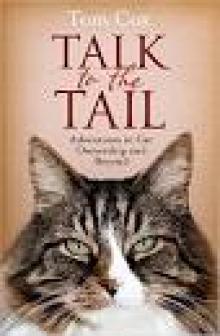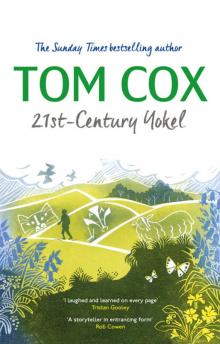21st-Century Yokel Read online
CONTENTS
1. Witches’ Knickers
2. WOFFAL
3. Two Otters, Seven Beavers, Two Rivers and a Lynx
4. The Hillocks Have Eyes
5. World Turned Upside Down
6. The Best Waves
7. Full Jackdaw
8. Boats Against the Current
9. Black Dog
10. Dawn of the Dad
Acknowledgements
Supporters
Copyright
Tom Cox lives in Devon. He is the author of, among others, the Sunday Times bestselling The Good, The Bad and The Furry and the William Hill Sports Book longlisted Bring Me the Head of Sergio Garcia.
BY THE SAME AUTHOR
Nice Jumper
Bring Me the Head of Sergio Garcia
Under the Paw
Talk to the Tail
The Good, The Bad and The Furry
Close Encounters of the Furred Kind
For The Bear (1995–2016) and Shipley (2001–2017).
RIP, little magicians.
Take the scorn and wear the horn
it was the crest when you were born
your father’s father wore it
and your father wore it too.
Hal-An-Tow (traditional)
Dear Reader,
The book you are holding came about in a rather different way to most others. It was funded directly by readers through a new website: Unbound. Unbound is the creation of three writers. We started the company because we believed there had to be a better deal for both writers and readers. On the Unbound website, authors share the ideas for the books they want to write directly with readers. If enough of you support the book by pledging for it in advance, we produce a beautifully bound special subscribers’ edition and distribute a regular edition and e-book wherever books are sold, in shops and online.
This new way of publishing is actually a very old idea (Samuel Johnson funded his dictionary this way). We’re just using the Internet to build each writer a network of patrons. At the back of this book you’ll find the names of all the people who made it happen.
Publishing in this way means readers are no longer just passive consumers of the books they buy, and authors are free to write the books they really want. They get a much fairer return too – half the profits their books generate, rather than a tiny percentage of the cover price.
If you’re not yet a subscriber, we hope that you’ll want to join our publishing revolution and have your name listed in one of our books in the future. To get you started, here is a £5 discount on your first pledge. Just visit unbound.com, make your pledge and type badger5 in the promo code box when you check out.
Thank you for your support,
Dan, Justin and John
Founders, Unbound
1
WITCHES’ KNICKERS
January. Haldon Hill, the border hill. Such a long, high wall in the sky as you approach it from the north-east, so thick with trees, always a tiny bit surprising that a few minutes later you can be on top of it in a car. Also surprising, perhaps, to my car itself, which lets out a harassed groan as I change gear for the final ascent. My ears pop hard as I reach the brow. It happens every time. When I’ve told hardy natives of the South West Peninsula the same thing, they have sometimes claimed I’m being overdramatic but I’m honestly not. Maybe it’s because my sensitive eustachian tubes spent too many years living closer to sea level, in a more recumbent landscape, but the altitude is too much for them. ‘Ppppop!’ they go, as always, maybe even a bit louder than usual today. What that noise signifies to me is that I have entered the unofficial country that I call home, comprising Cornwall and the western two thirds of Devon.
Haldon rises, dividing the land, around six miles south-west of Exeter, which has always struck me as the most sarcastically named of small cities: a place that, when you’re attempting to get out of it at rush hour, appears to have no exit at all. If you look at it another way, though, the name is apt. When you reside on the west side of Haldon Hill, as I do, Exeter feels like your exit to the rest of Britain: the beginning of that place which, when you’ve lived down here for any time at all, you start to think of as Everywhere Else. Draw a line directly south from Haldon’s summit and you reach the exact point where the cliffs change colour – soft sandy red giving way to gnashing dark grey. Haldon seems like a barrier and must have seemed an even bigger one before it was tarmacked over with dual carriageway. Evidence of several sunken medieval lanes ascending the hill has been found on its east side, but almost none on its western slopes. Weary fourteenth-century travellers from the east would arrive at Lidwell Chapel near the eastern base of Haldon and receive offers of hot food and a bed for the night from Robert de Middlecote, the monk who lived there. Middlecote would then drug them, cut their throats and dump their bodies in the well in the chapel’s garden – allegedly bottomless, like so much still water in folklore. ‘Ooh, bloody hell, I’m not going over that,’ you can imagine similarly weary Romans exclaiming, thirteen hundred years or so earlier, as Haldon came into view. ‘We’ve done enough conquering, anyway. Let’s just leave whoever lives over there to carry on cuddling boulders and worshipping trees, or whatever it is they do.’ The Deep South West was its own country then and remains so now. Making a home in it is still a commitment to a certain kind of life, with more potential to be a self-contained part of its own immediate surroundings. Pass over that long brow and the land begins to steepen and get more intimate with itself, employment becomes more scarce, communities become more scattered and the idea of a day trip to the middle of the country becomes more fatigue-inducing.
As often as not, you drive up to the top of Haldon in one kind of weather and descend in another. In Exeter today there’s been squally showers and the lingering grey of a collective tetchy mood, but as I come down the opposite side, the sun switches on its spotlight function and illuminates the valley. Dartmoor streaks away in front of me on the right, unearthly and moody and promising and electric. They say in Devon that if you can’t see the moor, it means it’s raining, and if you can see it, it means it’s about to rain. That’s a comic exaggeration, of course, but not a huge one. Today the moor looks like a giant outdoor factory where witches make weather. There are countless small bright gaps in the sky, like holes stabbed in a tent roof to let the light in, then longer, bigger, more jagged gaps, as if the person in the tent has lost patience and gone at it with a bread knife. Some hills are enigmatically yellow in a way that doesn’t seem to correspond with the cloud above them, others a dark green verging on black that’s no less confusing. I can’t get nonchalant about this view, and it’s become even more fascinating to me as I’ve become more intimate with the moor. I will glance across and try to work out which shape or shade might denote a patch where I’ve walked. Is that where the farm is that I walked past that time with the huge ball of wire outside with the variety of animal skulls placed in it? I will think. No. Perhaps that’s a couple of miles further north. Maybe it’s the wildflower meadow I was pursued across last April by a small, determined pig.
I press on past Heaven and Hell Junction, Heaven being the moor and Hell staring it down from across the tarmac in the form of Trago Mills, the vast, grotesque shopping and leisure park whose toxic-waste-dumping, UKIP-supporting, wildlife-shooting owners the Robertson family once printed adverts calling for the castration of gay men. Up another big hill, past Ashburton Junction One and Ashburton Junction Two – the one which looks like my junction, that I take by mistake when I’m tired – and I’m home, or as good as, heading seawards on the smaller road where home begins in the most graspable sense: a zigzagging one, full of roller-coaster dips and climbs. To the right of the road is the River Dart and, because the road attempts
to use the river as its guide, it is at the constant mercy of its indecision. All the Dartmoor rivers are capricious, but none that race down from the moor prevaricate about their route more often than the Dart. The hills here are not like those in Somerset or east Devon, which have wide valleys and plains between them; they are a community, bunching together as if nervously fearing solitude. The Dart finds the tight rare spaces between them and curls around them at flamboyant length, making its scenic way to the ocean.
Just two of the hills in this post-moor, pre-coast landscape rise up in a more noticeable, individual way. Unlike most of their less spellbinding neighbours, both of them are known locally by name. The bulkier of the two is called Hood Ball Hill, a corpulent sovereign of a hill topped with a copse somewhat resembling a mullet haircut. Its lankier neighbour, around a mile away, is called Yarner Beacon, although it was initially introduced to me as the Dragon’s Hoof, a name that became even more appealing upon my failure to substantiate it using any historical or electronic source.
At Hood Ball Hill’s foot, as well as the river and the bridge where the road crosses to the water’s eastern bank, is the track belonging to the Buckfastleigh to Totnes tourist railway. The steam from the trains that run along this enhance the hill’s mystic quality like dry ice around the ankles of a wizard. Talk to the more shamanistically inclined around here and they might tell you that Hood Ball Hill is the Atlantean Temple of the Moon, to which people have been known to travel many miles in order to face their shadow, or at least that a ley line passes directly through its centre, carrying mellow vibes down from Glastonbury, eighty miles to the north-east. In the late seventies an annual hippy fayre was held on its slopes. I met a carpenter called Brendan in the pub at Staverton, one of the two villages Hood Ball Hill overlooks, who attended the fayre regularly as a child and remembers it as an event where people often dressed in sackcloth and there were always ‘lots of dogs running loose and having a go at one another’.
Nowadays Hood Ball Hill has no footpath and is strictly, even a tad angrily, sectioned off from the public. I know this because I have checked out the situation assiduously from every angle. I have, however, climbed Yarner Beacon several times, both after the advent of the new permissive path leading to its peak and prior to that as a wide-eyed trespasser. For weeks before I made my maiden ascent, the beacon would call to me. Every time I saw it I could think about nothing but getting up into the comb of trees at its peak. This hill fetish was new to me and I did not understand what it meant or what I hoped to achieve through it, but if anything that made it all the more powerful. I had moved here from one of the flattest counties in England, Norfolk, where I once had a neighbour who spoke longingly of ‘living in a house on a hill’. It was quite a big deal to him since they only have about six of them there. I lived for a long spell after that on what I thought was a hill but now realise was only a tussock with ideas above its station. People visiting me from Devon said they liked the place but asked how I coped with the flatness. I didn’t understand what they meant. It was merely a topographical characteristic, surely, not a malady? But as a resident of Devon’s South Hams region I soon began to get it. Flat landscapes have a subtle enchantment of their own, but a landscape dense with hills makes everything more of a fascinating puzzle. Voices and revelations tend to flood the head on a good country walk, as if imparted by well-meaning unseen sprites hiding in the countryside itself. These voices and revelations are imbued with a different magic when emerging from the secret folds and crevices that hills create. Being accustomed to that magic, then visiting a place where it appears to have been steamrollered and rendered ostensibly more prosaic, must come as a shock.
I like to climb Yarner Beacon on a clear day, gaze several miles into the distance towards the sea and try to pick out the location of the footpaths I’ve walked, which, after three years of living here, is almost all of them. I once made the mistake of moving to an exciting new part of the British countryside and not immediately investigating every bit of it forensically on foot and I don’t intend to make the same error again. From up here I’m always amazed at the way all the threads connect, their shimmies and jinks and thrusts being disguised when you’re beneath hilltop level, in the thick of it. It could be compared to the moment when, having only previously travelled through London by Tube, a person explores the city at ground level on foot and realises the unexpected interconnectivity of the stations, their surprising proximity to one another. So many of the paths here in south-west Devon are of a hidden nature: sunken lanes that were already old in Saxon times, created by landowners digging ditches on the boundaries of their properties and piling earth into continuous banks on their own sides. These holloways feel impossibly solid when, as a walker, you’re bracketed by their banks below the bulk of the land, in an eerily quiet semi-subterranean shale, fern, mud and moss world.
In winter this countryside is a totally different colour to Norfolk’s: reddy brown and green, as opposed to grainy brown and muddy grey. Rich rain-sodden earth and leaf mulch provide the reddy brown; plentiful moss, resilient fern and lichen add back-up greens on the borders of fields and meadows that stay more emerald luminous in the cold months than any other fields and meadows I’ve known. There is a strong argument in favour of every season here: autumn for its crunchy lysergic coppers and golds, its sunlit spider’s webs and sudden forgotten woodsmoke rush; summer because summer here is just dizzying with all the possible ways it offers to fill your time. But in winter as the land strips itself back it shows you new secrets and you feel like you’re getting a glimpse into something special behind everything else: intangible, ghoulish, a necessary dark pigment on the edge of the land of the living.
Restless from driving, I arrive home and go straight out again on foot, wringing the daylight out of the day. On a steep rocky holloway leading down from the hamlet of Aish the leaf veil has fallen back to reveal a ruined barn I never knew was there. One of its broken woodworm-riddled doors creaks in the wind as I pass, which is odd, as I hadn’t realised there was any wind. At the bottom of the hill, beside a water lane, on a fence in a stark garden belonging to an isolated cottage a well-known death figure has been made using thick black polythene draped over two crossed sticks. Hooded and faceless, he holds a lantern in one unseen hand and a scythe in the other. I step gingerly over to photograph him, and a man of baby boomer age wearing a fisherman’s jumper emerges from the front door of the cottage. ‘Ooh, he loikes the reaper,’ he says to me in a strong West Country accent that leaves me unsure if it is genuine or being put on for hillbilly Straw Dogs effect. Something ominous hangs in the air for twenty seconds until a younger man – possibly his son – emerges from the house, chuckling. I ask the younger man if he made the reaper himself and he confirms that he did, with the help of friends, and that it was the centrepiece of a recent New Year’s Eve party. There is no such levity to explain away another haunting site I see six and a half miles upriver, near Staverton: a fence post, recently denuded of nettles and bracken and draped with a blue shawl, matching floppy felt hat and off-beige scarf to form what looks chillingly like a small, stooped woman, turned away from the footpath, crying over some crippling recent tragedy. Of these two ominous home-made figures this is undoubtedly the greater piece of art, constructed using nothing but a banal pre-existing boundary marker and three dirty pieces of clothing, yet conveying absolutely no sense that, were you to touch her and ask her if she was OK, she would not turn round with glowing crimson eyes and gnashing teeth, crunch your skull into fragments and suck fresh blood from your neck hole.
I hike these paths more often in winter, when daylight is scarce and I am reluctant to waste what there is of it on car journeys to further-flung walking destinations. South Devon is by far the most touristy place I’ve ever lived, but in January, February and March you can take a route across the hidden places and get a genuine sense that no other human feet have preceded yours for weeks. One of my favourite walks is a thirteen-mile loop to the village of Tu
ckenhay. I love the way the village looks from the top of the valley in winter, with smoke billowing from the chimneys beside the creek and the jumbled houses climbing into the narrow opposing valley as if forming an unruly queue for a magic tunnel. This most recent winter I walked down the steepest of the hills leading to the village and was reminded of the time my dad drove down the same lane in icy conditions in an old, untrustworthy car during a family holiday in 1987. With unintentional perfect timing Vivaldi’s ‘Winter’ had been playing on the car’s cassette player as he drove, and the combination of the perilous road and the hysteria of the music sent my mum, me and my auntie Mal into fits of laughter. Now, on the same hollowed-out road, I spotted a hubcap eight feet above me, lodged in the mossy, ivy-strangled bank; above it, brassy robins flitted about. How had it got all the way up there? Maybe the driver of the car it had been attached to had been listening to Vivaldi too, and got carried away. That is, if the hubcap was a hubcap and not a tiny flying saucer that had veered off course and crashed, which was what it more realistically resembled.
My preferred route back from Tuckenhay is the most arduous and impractical one, along the creek bed, where hopefully the tide will be low. The first time I was about to take this route I encountered two dishevelled, wheezing walkers coming from the opposite direction, who told me that I shouldn’t try to get down there, since they’d only just made it through, and they, unlike me, had walking poles and proper anoraks with labels on them. Had they known me, they would have realised that ‘I wouldn’t try to go that way if I were you – it’s difficult’ is one of the three main motivational hiking phrases a person can say in my vicinity, along with ‘There’s a great pub at the apex of this route’ and ‘This hill is well known due to the coven which is said to have practised in the copse at its plateau during the middle of the seventeenth century.’ I thanked them and pressed on in exactly the direction I’d intended, negotiating slimy pebbles and fallen trees with relatively little trouble. But this latest time along the creek was tough going. Rain had wrecked the valley for the previous five days. Vast mounds of slippy alien bubble seaweed sat on top of even slippier wet rocks, like the soggy crust of a treacherous pie. I took an hour to walk a broken studded necklace of land that I’d taken just fifteen minutes to make my way over last May. I only narrowly avoided tripping over, although in some ways it wouldn’t have mattered if I had, since I was already a six-foot strip of pure mud-spatter masquerading as a human male. I had some shopping to do on the route home and thanked my lucky stars that I lived in the kind of place where the sight of a man who looked like the Creature from the Black Lagoon buying biological washing liquid and bananas would raise few eyebrows. The seaweed smelled less pleasant than usual: it gave off a salty pungent rot threat. Some of it, blasted there by the storms of recent days during high tide, had caught in the branches of the gnarly oaks which stuck out on precarious crooked noses of granite above the creek. Above it was another lonely haunted-looking barn I’d not previously spotted. A few strands of black binliner were caught in the barbed wire of the adjoining field. I’d not all that long ago learned the excellent Irish term for such a phenomenon – witches’ knickers. The creek formed a thin channel through the mud, then rounded the corner to merge with the river, which, like all other rivers in Devon at this time of year, had acquired that black look it does not possess even on the coldest and most unforgiving day of autumn, summer or spring. It whispered in my ear about the bad stuff it wanted to do to me, and I climbed away, back to higher, more solid earth, relieved. Further on, in a hedge on the hill above Sharpham, near the natural burial ground, I saw another example of witches’ knickers, far more elaborately and eerily crafted by nature: a curved strip of former black bag, complete with hood and slanted eyehole, which only someone in the most fierce denial about the dark side of existence would fail to admit looked like a demon – if not the Devil himself – reclining among the thin twigs, watching weary travellers struggle up the hill and idly planning their fate. If I looked closer, which I did not quite want to, I half-expected him to be casually examining his fingernails. A few weeks earlier similar nearby hedgerows had been strewn with redoubtable, undying wild clematis. Forgetting what the folklore name for it was, I asked a man emerging from a nearby garden if he knew. ‘Those? They’s dead men’s whiskers,’ he said. He was incorrect; the name I was looking for was in fact old man’s beard, but I preferred his term and resolved to use it on all tenable future occasions. Now, though, the wild clematis seemed to have vanished. We had entered January, winter’s peak. Time of tax return terror, bare trees, delusional gym resolutions and scheming hedge demons. Too bleak even for the strong and wiry whiskers of the deceased.

 Ring the Hill
Ring the Hill Talk to the Tail
Talk to the Tail Help the Witch
Help the Witch Educating Peter
Educating Peter Nice Jumper
Nice Jumper 21st-Century Yokel
21st-Century Yokel Bring Me the Head of Sergio Garcia
Bring Me the Head of Sergio Garcia The Good, the Bad, and the Furry
The Good, the Bad, and the Furry